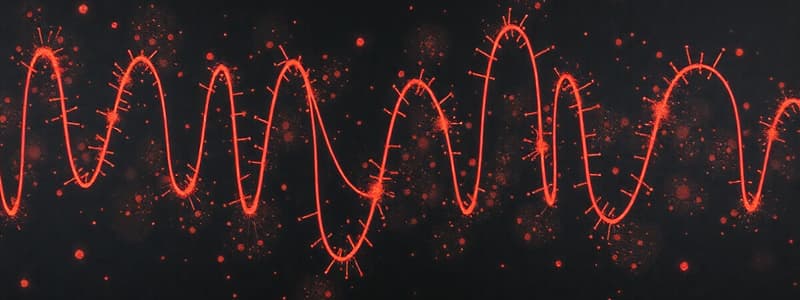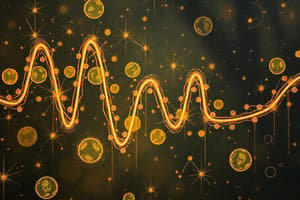Podcast
Questions and Answers
What is the threshold potential that must be reached to initiate an action potential?
What is the threshold potential that must be reached to initiate an action potential?
- -90 mV
- -55 mV (correct)
- -70 mV
- +30 mV
During depolarization, which ion channels open allowing sodium ions to enter the cell?
During depolarization, which ion channels open allowing sodium ions to enter the cell?
- Mechanically gated K+ channels
- Voltage-gated K+ channels
- Ligand-gated Na+ channels
- Voltage-gated Na+ channels (correct)
What characterizes the absolute refractory period?
What characterizes the absolute refractory period?
- K+ channels are still open
- A strong stimulus can initiate an action potential
- A neuron can fire another action potential
- Inactivated Na+ channels need to return to resting state (correct)
What happens to the membrane potential during repolarization?
What happens to the membrane potential during repolarization?
How much sodium actually enters the cell during the depolarization phase?
How much sodium actually enters the cell during the depolarization phase?
Which phase of the action potential involves the outflow of potassium ions?
Which phase of the action potential involves the outflow of potassium ions?
What occurs during the relative refractory period?
What occurs during the relative refractory period?
What is the typical resting membrane potential of a neuron?
What is the typical resting membrane potential of a neuron?
What is the role of refractory periods in action potential propagation?
What is the role of refractory periods in action potential propagation?
Which type of conduction involves step-by-step depolarization along the axolemma?
Which type of conduction involves step-by-step depolarization along the axolemma?
In saltatory conduction, where does depolarization primarily occur?
In saltatory conduction, where does depolarization primarily occur?
How does the flow of sodium ions affect action potential propagation?
How does the flow of sodium ions affect action potential propagation?
What is a nerve impulse also referred to as?
What is a nerve impulse also referred to as?
Which statement is true regarding the propagation speed of a nerve impulse?
Which statement is true regarding the propagation speed of a nerve impulse?
What distinguishes saltatory conduction from continuous conduction?
What distinguishes saltatory conduction from continuous conduction?
What happens to the action potential as Na+ flows into the cell during depolarization?
What happens to the action potential as Na+ flows into the cell during depolarization?
Which type of nerve fibers are the largest and conduct impulses at the fastest rate?
Which type of nerve fibers are the largest and conduct impulses at the fastest rate?
What characterizes the conduction speed of C fibers compared to A fibers?
What characterizes the conduction speed of C fibers compared to A fibers?
What is the primary mechanism by which stimulus intensity is encoded?
What is the primary mechanism by which stimulus intensity is encoded?
Which effect do local anesthetics such as lidocaine have on action potentials?
Which effect do local anesthetics such as lidocaine have on action potentials?
What type of synapse directly allows electrical activity to pass between two neurons?
What type of synapse directly allows electrical activity to pass between two neurons?
How do neurotransmitters at a chemical synapse influence the postsynaptic neuron?
How do neurotransmitters at a chemical synapse influence the postsynaptic neuron?
Which type of fiber is primarily involved in transmitting visceral sensory information?
Which type of fiber is primarily involved in transmitting visceral sensory information?
What impact does a firm pressure stimulus have compared to a light touch?
What impact does a firm pressure stimulus have compared to a light touch?
What initiates the release of neurotransmitters at a chemical synapse?
What initiates the release of neurotransmitters at a chemical synapse?
Which statement correctly describes an excitatory postsynaptic potential (EPSP)?
Which statement correctly describes an excitatory postsynaptic potential (EPSP)?
What is the key difference between EPSP and IPSP?
What is the key difference between EPSP and IPSP?
Which of the following describes the synaptic delay in chemical synapses?
Which of the following describes the synaptic delay in chemical synapses?
What occurs during the binding of neurotransmitter to ligand-gated receptors?
What occurs during the binding of neurotransmitter to ligand-gated receptors?
What is the role of the postsynaptic cell in response to inhibitory postsynaptic potential (IPSP)?
What is the role of the postsynaptic cell in response to inhibitory postsynaptic potential (IPSP)?
What characterizes the information transfer in chemical synapses?
What characterizes the information transfer in chemical synapses?
What results from the influx of Cl- or K+ ions during synaptic transmission?
What results from the influx of Cl- or K+ ions during synaptic transmission?
What defines the magnitude of graded potentials?
What defines the magnitude of graded potentials?
What does summation of graded potentials refer to?
What does summation of graded potentials refer to?
Where do graded potentials primarily occur within a neuron?
Where do graded potentials primarily occur within a neuron?
Which is true about action potentials?
Which is true about action potentials?
What happens to the membrane potential during depolarization?
What happens to the membrane potential during depolarization?
Which channels open first during the generation of an action potential?
Which channels open first during the generation of an action potential?
What is a characteristic feature of graded potentials?
What is a characteristic feature of graded potentials?
What principle governs the generation of an action potential?
What principle governs the generation of an action potential?
Flashcards are hidden until you start studying
Study Notes
Graded Potentials
- Graded potentials are localized changes in membrane potential.
- The magnitude of the potential change varies depending on the strength of the stimulus.
- Graded potentials are decremental; the potential change decreases with distance from the stimulus.
- Graded potentials can summate, meaning that multiple stimuli can combine to create a larger potential change.
- Graded potentials occur most often in the dendrites and cell body of a neuron.
Action Potential
- An action potential (AP) is a rapid sequence of events that reverses the membrane potential and then restores it to resting state.
- During an AP, voltage-gated Na+ and K+ channels open in a specific sequence.
- The all-or-none principle states that if a stimulus reaches threshold, an AP will occur with the same magnitude, regardless of the stimulus strength.
Depolarization Phase
- A stimulus causes a graded potential to reach threshold (-55 mV).
- Voltage-gated Na+ channels open, allowing Na+ to flow into the cell.
- The influx of Na+ rapidly depolarizes the membrane, reaching a peak of +30 mV.
Repolarization Phase
- Voltage-gated K+ channels open slowly, and K+ flows out of the cell.
- The outflow of K+ repolarizes the membrane, returning it to the resting potential (-70 mV).
After-Hyperpolarization
- If enough K+ leaves the cell, it will reach a membrane potential of -90 mV.
- K+ channels close, and the Na+/K+ pump restores the membrane potential to -70 mV.
Refractory Period
- The refractory period is a time during which a neuron cannot generate another action potential.
- The absolute refractory period occurs when Na+ channels are inactivated and cannot be reopened, even with a strong stimulus.
- The relative refractory period occurs when K+ channels are still open, but Na+ channels have closed. A suprathreshold stimulus can still initiate an AP during this period.
Propagation of Action Potentials
- The AP spreads along the axon membrane.
- The influx of Na+ at one point depolarizes the adjacent region, triggering the opening of voltage-gated Na+ channels and propagating the AP.
- The traveling AP is called a nerve impulse.
Continuous vs. Saltatory Conduction
- Continuous conduction occurs in unmyelinated fibers.
- Saltatory conduction occurs in myelinated fibers.
- Saltatory conduction is faster than continuous conduction because the AP only occurs at the nodes of Ranvier, where voltage-gated ion channels are concentrated.
Speed of Impulse Propagation
- The speed of impulse propagation is not dependent on stimulus strength.
- Larger, myelinated fibers conduct impulses faster due to their size and saltatory conduction.
Types of Nerve Fibers
- Type A fibers are the largest and fastest, myelinated, and transmit somatic sensory and motor signals to skeletal muscle.
- Type B fibers are medium-sized, myelinated, and transmit visceral sensory and autonomic preganglionic signals.
- Type C fibers are the smallest and slowest, unmyelinated, and transmit sensory and autonomic motor signals.
Encoding of Stimulus Intensity
- The nervous system differentiates between stimuli of different intensities through:
- Frequency of impulses: Stronger stimuli generate higher frequency impulses.
- Number of sensory neurons activated: Stronger stimuli activate a larger number of neurons.
Clinical Effects of Action Potential Inhibition
- Local anesthetics, such as procaine and lidocaine, block voltage-gated Na+ channels, preventing action potential generation.
- This blocks pain signals from reaching the brain.
Synapses
- A synapse is a specialized junction between two neurons.
- Synapses can be electrical or chemical.
- Electrical synapses allow direct current flow between neurons through gap junctions.
- Chemical synapses involve the release of neurotransmitters from the presynaptic neuron, which bind to receptors on the postsynaptic neuron.
Chemical Synapses
- When an AP reaches the axon terminal, voltage-gated Ca2+ channels open.
- Ca2+ influx triggers the release of neurotransmitters.
- Neurotransmitters diffuse across the synaptic cleft and bind to receptors on the postsynaptic neuron.
- The amount of neurotransmitter released determines the magnitude of the postsynaptic potential change.
Excitatory & Inhibitory Potentials
- Neurotransmitters can be excitatory or inhibitory.
- An excitatory postsynaptic potential (EPSP) is a depolarizing graded potential that increases the likelihood of the postsynaptic neuron reaching threshold.
- An inhibitory postsynaptic potential (IPSP) is a hyperpolarizing graded potential that decreases the likelihood of the postsynaptic neuron reaching threshold.
Studying That Suits You
Use AI to generate personalized quizzes and flashcards to suit your learning preferences.



